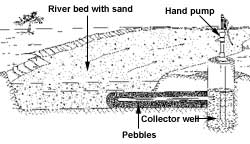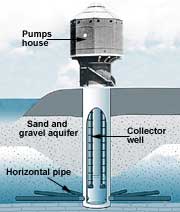
Vol. 5
No.
1
February 2002
![]()
Catch water from riverbed
Most of the seasonal riverbeds remain without any surface flow during non-monsoon period. However, the sand deposits on these riverbeds are generally saturated with water that could be effectively tapped by constructing infiltration galleries and radial collector wells. This practice is common in the Indian states like Gujarat and Andhra Pradesh.
 |
Figure1: Infiltration galleries |
The infiltration galleries consist of open well on the riverbank. The well is connected to the riverbed by a horizontal perforated pipe to collect water. The water entrapped in the sediments of riverbed gets filtered before entering the well through the pipe by gravity flow. Pebble pitching done around the pipe prevents the fine sand particles from entering the well. From the well the water can be extracted either by power pump or by hand pump. (see figure1: Infiltration galleries) Different types of galleries can be designed according to local condition Ð they could be constructed parallel or across riverbeds.
 |
Figure 2: Radial collector wells |
Radial wells are quite similar to the infiltration galleries, however they are constructed on the riverbed itself instead of on riverbank. They are circular wells that are constructed in the center of the riverbed.
From the bottom of the well, perforated pipes are laid out in all directions. The length of the pipes range from 10 to 15 meters. These pipes divert water from the sediments to open well through the gravity flow.
(see figure 2: Radial collector wells) The water collected in the well can be pumped out using power pumps.The thickness of sand deposits on the riverbed directly determines the amount of water that can be extracted from both these wells. Many of these wells are abandoned, due to illegal sand quarrying from the riverbed. There is an urgent need to control this illegal practice that would solve the water problem of many villages.
Source:http://www.reynoldsinc.com
http://faillace.india.teejay.net